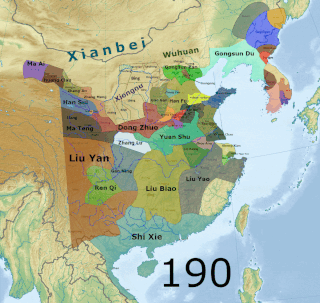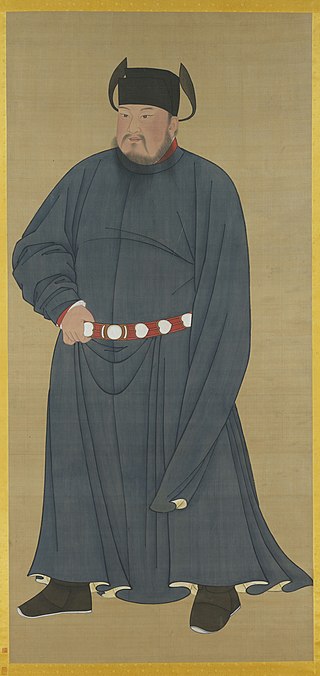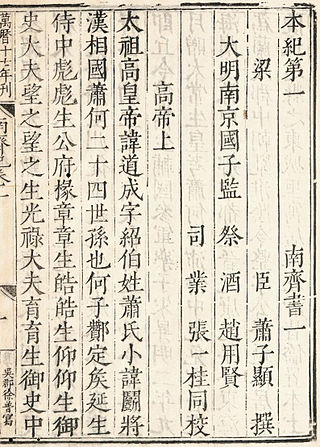Chinese classic texts or canonical texts or simply dianji (典籍) refers to the Chinese texts which originated before the imperial unification by the Qin dynasty in 221 BC, particularly the "Four Books and Five Classics" of the Neo-Confucian tradition, themselves a customary abridgment of the "Thirteen Classics". All of these pre-Qin texts were written in classical Chinese. All three canons are collectively known as the classics.

The Three Kingdoms from 220 to 280 AD was the tripartite division of China among the dynastic states of Cao Wei, Shu Han, and Eastern Wu. The Three Kingdoms period was preceded by the Eastern Han dynasty and was followed by the Western Jin dynasty. The short-lived state of Yan on the Liaodong Peninsula, which lasted from 237 to 238, is sometimes considered as a "4th kingdom".

Qi, known in historiography as the Southern Qi or Xiao Qi, was a Chinese imperial dynasty and the second of the four Southern dynasties during the Northern and Southern dynasties era. It followed the Liu Song dynasty and was succeeded by the Liang dynasty. The main polity to its north were the Northern Wei.

The Chen dynasty, alternatively known as the Southern Chen in historiography, was a Chinese imperial dynasty and the fourth and last of the Southern dynasties during the Northern and Southern dynasties period. Following the Liang dynasty, the Chen dynasty was founded by Chen Baxian. The Chen dynasty further strengthened and revitalized the economy and culture of southern China, and made territorial expansions northward, laying the foundation for future dynasties. It was conquered by the Sui dynasty in 589, marking an end to the Northern and Southern dynasties period in Chinese history. The descendants of the Chen imperial family continued to hold powerful high-ranking positions in the imperial courts of both the Sui and Tang dynasties.
Dynasties in Chinese history, or Chinese dynasties, were hereditary monarchical regimes that ruled over China during much of its history. From the legendary inauguration of dynastic rule by Yu the Great c. 2070 BC to the abdication of the Xuantong Emperor on 12 February 1912 in the wake of the Xinhai Revolution, China was ruled by a series of successive dynasties. Dynasties of China were not limited to those established by ethnic Han—the dominant Chinese ethnic group—and its predecessor, the Huaxia tribal confederation, but also included those founded by non-Han peoples.

The Records of the Three Kingdoms, is a Chinese imperial history that covers the end of the Han dynasty and the following Three Kingdoms period (220–280 CE). It is widely regarded as the official and authoritative source text for these periods. Written by Chen Shou after the Jin dynasty reunited China in the third century, the work compiles the political, social, and military events within rival states Cao Wei, Shu Han and Eastern Wu into a single text organized by individual biography.

Chen Shou, courtesy name Chengzuo (承祚), was a Chinese historian, politician, and writer who lived during the Three Kingdoms period and Jin dynasty of China. Chen Shou is most known for his most celebrated work, the Records of the Three Kingdoms (Sanguozhi), which records the history of the late Eastern Han dynasty and the Three Kingdoms period. Chen Shou wrote the Sanguozhi primarily in the form of biographies of notable persons of those eras. Today, Chen's Records of the Three Kingdoms is part of the Twenty-Four Histories canon of ancient Chinese history.
Emperor Wu or the Wu Emperor is the posthumous name of numerous Chinese rulers:
The Book of Liang, was compiled under Yao Silian and completed in 635. Yao heavily relied on an original manuscript by his father Yao Cha, which has not independently survived, although Yao Cha's comments are quoted in several chapters.
The Book of Wei, also known by its Chinese name as the Wei Shu, is a classic Chinese historical text compiled by Wei Shou from 551 to 554, and is an important text describing the history of the Northern Wei and Eastern Wei from 386 to 550. Widely regarded as the official and authoritative source historical text for that period, it is one of the Twenty-Four Histories.

Emperor Zhuangzong of Later Tang, personal name Li Cunxu, nickname Yazi (亞子), stage name Li Tianxia (李天下), was the ruling prince of the Former Jin dynasty and later became the founding emperor of the Later Tang dynasty during the Five Dynasties and Ten Kingdoms period of Chinese history. He was the son of Li Keyong, an ethnic Shatuo Jiedushi of the Tang dynasty.

Wang Shenzhi, courtesy name Xintong (信通) or Xiangqing (詳卿), formally Prince Zhongyi of Min (閩忠懿王) and later further posthumously honored as Emperor Taizu of Min (閩太祖), was the founder of Min Kingdom on the modern southeast coastal province of Fujian province in China during the Five Dynasties and Ten Kingdoms period of ancient Chinese history. He was from Gushi in modern-day Henan.
The History of the Northern Dynasties is one of the official Chinese historical works in the Twenty-Four Histories canon. The text contains 100 volumes and covers the period from 386 to 618, the histories of Northern Wei, Western Wei, Eastern Wei, Northern Zhou, Northern Qi, and Sui dynasty. Like the History of the Southern Dynasties, the book was started by Li Dashi and compiled from texts of the Book of Wei and Book of Zhou. Following his death, Li Yanshou (李延寿), son of Li Dashi, completed the work on the book between 643 and 659. Unlike most of the rest of the Twenty-Four Histories, this work was not commissioned by the state.

The Book of Qi or Book of Southern Qi is a history of the Chinese dynasty Southern Qi covering the period from 479 to 502, and is one of the Twenty-Four Histories of Chinese history. It was written by Xiao Zixian during the succeeding Liang Dynasty. This book was the only one of the Twenty-Four Histories to be authored by a member of the chronicled dynasty's ruling house – Xiao Zixian was a grandson of Emperor Gao, founder of Southern Qi,
The Historical Records of the Five Dynasties is a Chinese history book on the Five Dynasties period (907–960), written by the Song dynasty official Ouyang Xiu in private. It was drafted during Ouyang's exile from 1036 to 1039 but not published until 1073, a year after his death. An abridged English translation by Richard L. Davis was published in 2004.
The Old History of the Five Dynasties was an official history mainly focus on Five Dynasties era (907–960), which controlled much of northern China. And it also includes some history of other south states during the era. It was compiled by the Song dynasty official-scholar Xue Juzheng in the first two decades of the Song dynasty, which was founded in 960. It is one of the Twenty-Four Histories recognized through Chinese history.
The Book of Chen or Chen Shu was the official history of the Chen dynasty, one of the Southern Dynasties of China. The Book of Chen is part of the official Twenty-Four Histories of imperial China. It was compiled by the Tang dynasty historian Yao Silian and completed in 636 AD. The Chen Shu is a biographical history book with thirty-six volumes, recording the historical facts of 33 years from the accession of Chen Baxian to the last emperor Chen Shubao.
Pei Songzhi (372–451), courtesy name Shiqi, was a Chinese historian and politician who lived in the late Eastern Jin dynasty and the Liu Song dynasty. His ancestral home was in Wenxi County, Shanxi, but he moved to the Jiangnan region later. He is best known for making annotations to the historical text Records of the Three Kingdoms (Sanguozhi) written by Chen Shou in the third century, providing additional details omitted from the original work. His commentary, completed in 429, became integral to later editions of the Sanguozhi, making the joint work three times as long as the original. His son, Pei Yin (裴駰), and great-grandson Pei Ziye (裴子野), were also well-known historians.
Yang Wo, courtesy name Chengtian, formally Prince Wei of Hongnong, later further posthumously honored King Jing of Wu and then as Emperor Jing of Wu with the temple name Liezu, was the first independent ruler of the dynastic state of Yang Wu during the Five Dynasties and Ten Kingdoms period of China.

The military history of the Five Dynasties and Ten Kingdoms covers the period of Chinese history from the collapse of the Tang dynasty in 907 to the demise of Northern Han in 979. This period of Chinese history is noteworthy for the introduction of gunpowder weapons and as a transitional phase from the aristocratic imperial system to the Confucian bureaucracy which characterized the Song, Ming, and Qing dynasties.








